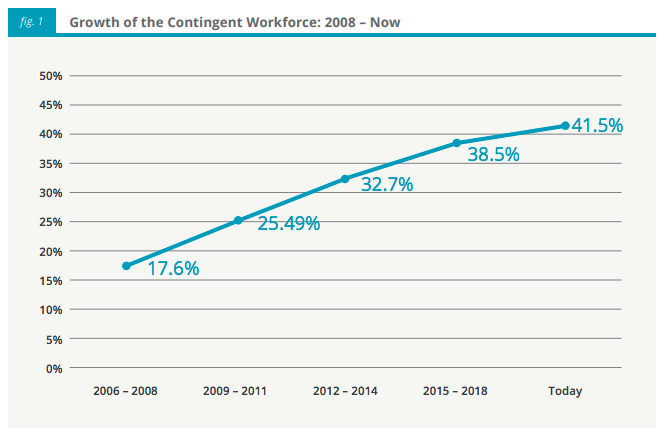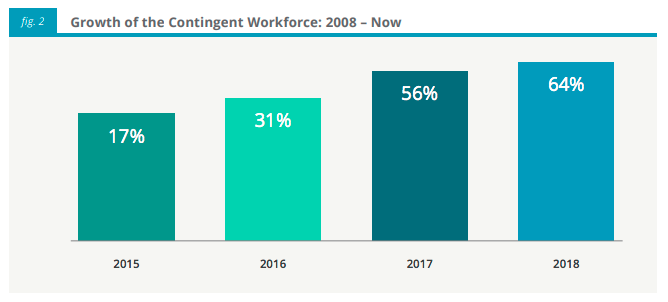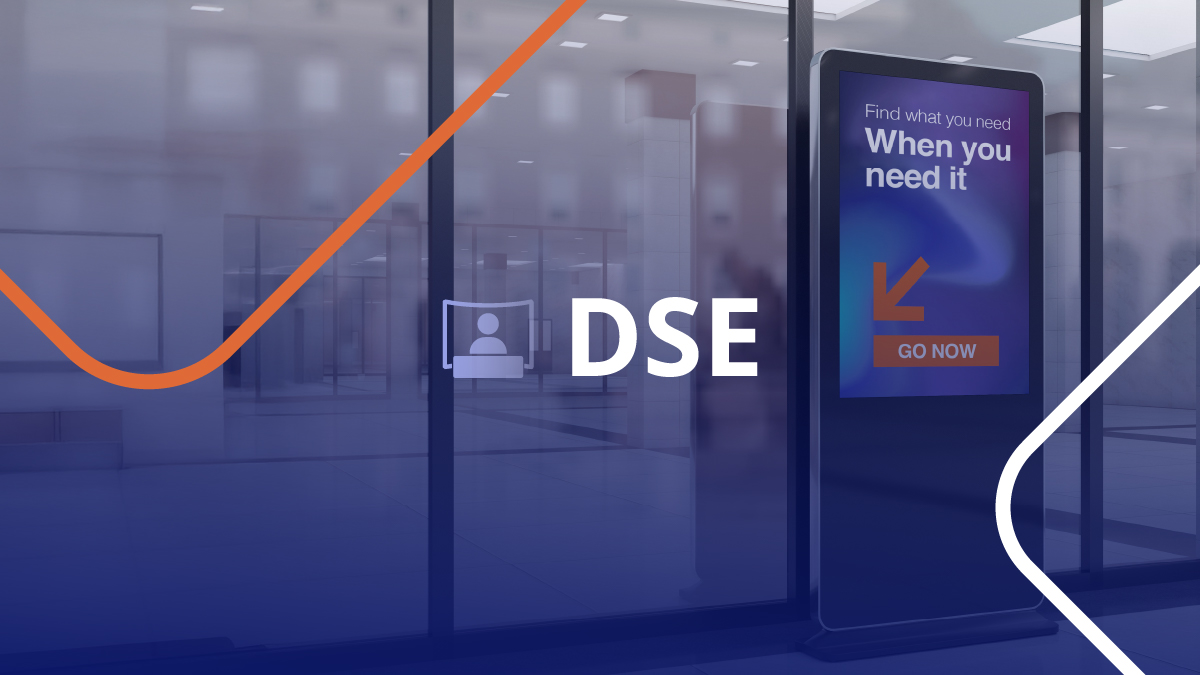
Introduction
The contingent workforce has been on a sharp growth trajectory for the past decade. Currently sitting at 41.5% of the average company’s overall talent pool, the contingent workforce of 2019 brings about a range of challenges and benefits. While many of these workers are remote or virtual (contributing to digital-based enterprise projects), there are many industries and sectors that directly leverage a critical volume of “on-site” non-employee workers. This reliance on the on-site contingent workforce creates a host of unique issues not prevalent in traditional temporary labor, including security concerns, compliance with industry certifications and specifications, and the overall quality and impact of service-oriented work. This Ardent Partners research report will analyze and discuss the major trends for on-site contingent workforce management (CWM), as well as highlight areas of innovation and provide strategic guidance for those enterprises planning to leverage this type of talent in 2019.
The New World of Work, Fueled by Non-Employee Talent
The “new world of work” is a combination of innovation and new, strategic thinking. Key factors such as advanced talent acquisition solutions, interconnected enterprise systems that enhance organizational intelligence, and flexible, transformational thinking regarding the business’ utilization of talent, all contribute to this dynamic new realm. One key element of this evolving world of work is business’ increasing reliance on the contingent workforce. New Ardent Partners research shows that 41.5% of the average enterprise’s total workforce is considered non-employee, a figure which includes traditional temporary workers (sourced via staffing agencies and vendors), independent contractors, freelancers, professional services, and “gig” workers.
The non-employee workforce has grown by roughly 2.5-times (see figure 1) over the past decade due to several important factors: 1) non-employee talent offers lower fixed costs than traditional talent, 2) this workforce often enables greater financial agility, 3) there is significant ease-of-use in many new technologies aimed towards on-demand talent engagement (e.g., digital staffing), and, in many cases, 4) the contingent workforce delivers a better alignment between talent/skillsets and the projects that require real-time expertise.
The new approaches towards managing non-employee talent represent an innovative path ahead for businesses: as more and more enterprises strive for true business agility, the contingent workforce evolves into the agile workforce.
As organizations seek to compete more aggressively, address new and dynamic business challenges, and, ultimately, thrive in the years ahead, they require more flexible skillsets and superior expertise to support their responses to shifting market pressures. The agile workforce represents the next logical step in the history of the non-employee workforce. And, as innovation, transformation, and the general speed of business all continue to progress, it will be this type of talent that increases in prominence and impact.
Top Trends in “On-Site” Contingent Workforce Management
The benefits of the contingent workforce align with the ultimate pursuit of the agile workforce. Businesses will find that variable/flexible cost models, consistent productivity, ease of engagement, and the overall “adaptability” of this talent to the projects that need them, all contribute to a business world that essentially depends on its total talent pool to succeed in a globalized market.
Although today’s contingent workforce can be broken into several categories (from traditional staffing supplier-sourced workers to freelancers engaged directly or via online/digital channels), there are major differences within this large pool of workers, because not all non-employee labor-driven projects are managed and monitored via virtual means. In fact, many industries [including manufacturing facilities, utilities (oil/gas) providers, retailers, foodservice organizations, etc.] have steadily increased their use of contingent labor for on-site projects, such as field service and maintenance. Although there are many similarities between traditional and on-site contingent labor, the fact that external workers contribute to, lead, and manage service-oriented (and similar) projects within a company’s physical location, adds several layers of complexity. In fact, Ardent Partners research has identified the top trends for on-site contingent and non-employee talent in 2019, including:
Both “hard skills” and “soft skills” will converge within the on-site contingent workforce. As detailed in Ardent’s annual State of Contingent Workforce Management 2018-2019 research study series, soft skills, such as collaboration, attitude, cognitive intelligence, negotiation skills, etc., are fast-becoming the most attractive qualities in potential candidates. However, within the on-site contingent workforce, “hard skills” related to specific technologies and mechanical hardware are often what set top-tier workers from less-skilled peers. From this comes a tipping point: the convergence of hard and soft skills in on-site contingent labor. Attributes such as social and collaborative skills, responsiveness, and consistent communication will become just as important as the hard skills that are so prevalent in the on-site contingent workforce.
Traditional business functions will see a greater infusion of non-employee talent in 2019. One of the more interesting impact areas of the Gig Economy is its propensity for transformational thinking; that is, more and more business executives are shifting their talent acquisition strategies to account for the rise, growth, and ultimate value of non-employee labor. For industries that rely on on-site contingent labor, this will signal an infusion of external talent within traditional roles that may have been “off-limits” for this type of talent in the past. In 2019, there are very few roles within the average organization that cannot be addressed with contingent labor.
The general growth of the non-employee workforce will force businesses to place more emphasis on addressing tactical challenges, such as compliance and financial operations. No matter the type of contingent talent being leveraged, there are always various considerations and risks that arise, including compliance with legal and regulatory policies, visibility challenges, and other tactical problems (i.e., payroll). And, as the non-employee workforce continues to grow in size and utilization, Ardent expects that many of these issues will be compounded in 2019. As enterprises that heavily-leverage on-site contingent talent are actively experiencing, it can be difficult to organize the more tactical components of contingent workforce management, particularly process-oriented capabilities (like payroll and payment management). On-site contingent labor also brings about its own specific challenges, as well, including security concerns, compliance with industry certifications, etc.
The “blended workforce” will spark a new approach towards total workforce management. As Ardent’s latest research has shown, 41.5% of the average company’s workforce is considered non-employee. This figure reinforces the fact that, as the workforce becomes more “blended,” the concept of “total workforce management” will be a necessary program for those organizations that want to standardize and centralize all acquisition and management of both sides of their workforce (non-employee and FTEs) under a single program. Enterprises that seek visibility into their total workforce and the ability to react to dynamic business challenges with the best-aligned talent in mind will find that total workforce management will be the ultimate key to true business agility.
Digital Staffing’s Play in On-Site CWM
Perhaps the most interesting aspect of innovation in the greater world of talent is the continued growth of digital and online staffing providers. Digital staffing platforms have emerged as a primary solution in the quest to engage the best-fit talent and maintain control over the acquisition process. In fact, Ardent Partners research has tracked the utilization of these marketplaces for the past several years and found that usage of digital staffing platforms has increased over threefold since 2015 (see Figure 2).
And, many of these digital staffing/talent providers offer a suite of workforce management functionality to facilitate both the tactical and strategic elements of CWM, such as:
Giving service providers and freelancers the ability to communicate in real-time with their clients (to resolve issues, confirm appointment times, etc.).
• Facilitating on-demand project management to ensure jobs are completed to the satisfaction of customers.
• Automating worker payments through the platform.
• Understanding current service coverage gaps across business units and locations and aligning the best-fit talent to those needs/projects (including freelancers in the network, private service providers, traditional FTEs, etc.), and;
• Ensuring that all workers and contractors within the digital network have required certifications and insurance.
CWM Guidance for 2019… and Beyond
Although virtual and remote work has become a critical component of everyday business, the fact remains that there are many industries in which non-employee labor is an incredible asset for on-site projects and initiatives. And, organizations that currently leverage on-site contingent labor almost certainly expect continued growth well into 2019. The following strategic recommendations and points of guidance will help businesses that rely on these types of non-employee workers to not only drive more value, but ultimately ensure that CWM initiatives are positioned for true enterprise agility.
1. Leverage enterprise intelligence to predict the future demand for non-employee talent and other workforce management insights.
Predictive analysis has become one of the hottest facets of business intelligence in 2019, as the ability to “see the future” is a fantastic way for businesses to make decisions today that will result in a better tomorrow. Which coverage areas will have the biggest talent gaps in six months? Which service providers are the best fit for future initiatives? Questions like these are better answered when teams can harness the power of data and intelligence regarding the greater talent pool, including service providers, contractors, and freelance talent.
2. Augment traditional temporary staffing with digital and online providers.
There is a major reason why the utilization of digital talent providers has grown threefold in the past three years. These on-demand marketplaces not only provide users with a vast network of talent but also harness unique algorithms to promote an ideal project-to-worker alignment. Many of these platforms also offer fully-automated workforce management tools to augment, support, and enhance overall contingent workforce management.
3. Embrace innovation and new modes of thinking when it comes to talent and technology.
The “Future of Work” is predicated on the convergence of talent and technology; thus, it is critical for business leaders to embrace the major shifts and changes happening in the greater market. Mobile applications are transforming communication between businesses and its service providers. Digital staffing (as mentioned above) is revolutionizing how enterprises can find and engage the best-fit talent. And, most importantly: the “talent-first” economy is the future, and the businesses that buy into this notion will be the ones that will be able to compete in the fast-paced business world.
4. Link the utilization of on-site contingent labor with the greater concept of business agility.
Business agility improves an organization’s ability to react to new challenges in a dynamic manner. It is becoming incredibly clear that talent and expertise is a crucial driving force behind the agile enterprise. The very underlying components of the agile workforce are rooted in the idea that, at the end of the day, it is the ultimate business outcome that is more important than anything else within the organization. For those industries that rely heavily on on-site freelancers and contractors, the concept of an agile workforce translates into an improved ability to get work done in the highest-quality manner possible. An agile viewpoint of non-employee labor will allow these organizations to better balance ongoing projects and critical business needs with the best-aligned talent when and where it is needed.








